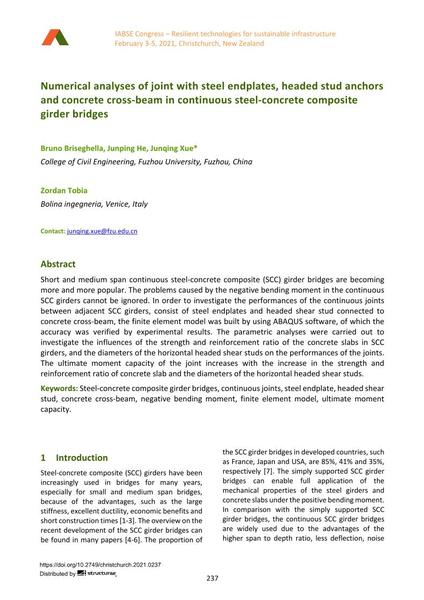Numerical analyses of joint with steel endplates, headed stud anchors and concrete cross-beam in continuous steel-concrete composite girder bridges

|
|
|||||||||||
Détails bibliographiques
| Auteur(s): |
Bruno Briseghella
Junping He (College of Civil Engineering, Fuzhou University, Fuzhou, China) Junqing Xue (College of Civil Engineering, Fuzhou University, Fuzhou, China) Zordan Tobia (Bolina ingegneria, Venice, Italy) |
||||
|---|---|---|---|---|---|
| Médium: | papier de conférence | ||||
| Langue(s): | anglais | ||||
| Conférence: | IABSE Congress: Resilient technologies for sustainable infrastructure, Christchurch, New Zealand, 3-5 February 2021 | ||||
| Publié dans: | IABSE Congress Christchurch 2020 | ||||
|
|||||
| Page(s): | 237-244 | ||||
| Nombre total de pages (du PDF): | 8 | ||||
| DOI: | 10.2749/christchurch.2021.0237 | ||||
| Abstrait: |
Short and medium span continuous steel-concrete composite (SCC) girder bridges are becoming more and more popular. The problems caused by the negative bending moment in the continuous SCC girders cannot be ignored. In order to investigate the performances of the continuous joints between adjacent SCC girders, consist of steel endplates and headed shear stud connected to concrete cross-beam, the finite element model was built by using ABAQUS software, of which the accuracy was verified by experimental results. The parametric analyses were carried out to investigate the influences of the strength and reinforcement ratio of the concrete slabs in SCC girders, and the diameters of the horizontal headed shear studs on the performances of the joints. The ultimate moment capacity of the joint increases with the increase in the strength and reinforcement ratio of concrete slab and the diameters of the horizontal headed shear studs. |
||||
